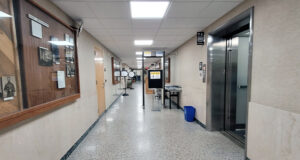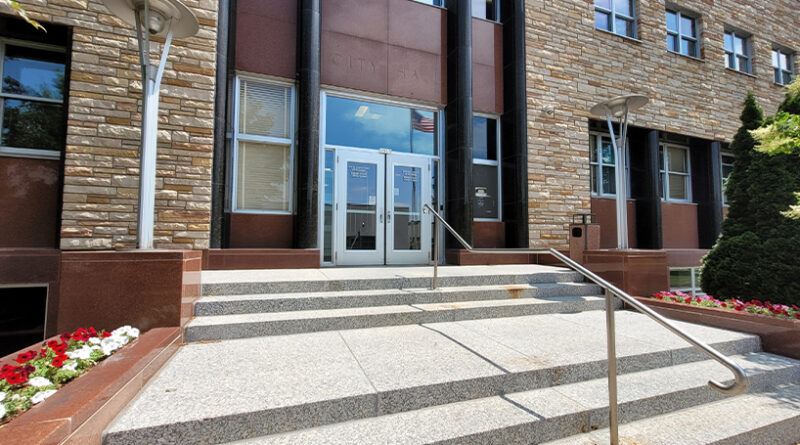City: Courtroom security is county’s problem, not ours
By Brandi Makuski
County leaders are planning improvements at the courthouse, one of which might involve closing down public access on the city’s side of the building and creating a single point of entry with a screening station.
The June 6 Space and Properties Committee voted to have county staff develop a cost and conceptual plan for safety upgrades at the County-City Building, 1516 Church St.
Plans include new windows, elevator, and technology/fiber updates, installation of fire sprinklers and new fire alarms, and asbestos removal.
Todd Neuenfeldt, facilities management director for the county, said the upgrades will cost close to $10 million.
“This gets us started, without doing any remodeling,” Neuenfeldt told the Committee. “I’m not saying when we’re all done, we’ll have a modern-day courthouse. We can improve it but we’ll never fix it.”
Among the top concerns are security for the second-floor courtrooms. Portage Co. has three circuit court branches and one family courtroom, but county and court officials have long expressed concerns about victims, defendants, jurors, and the public being forced to pass each other in the same hallway.
Also concerning is the screening area, which puts a metal detector halfway down the second-floor hallway, past two court branch offices, and a public elevator. It is the only active security feature in the building.

County Board Supervisor Mike Splinter (D12) said if someone entered the building with a firearm, they could take the elevator to the second floor, step off, and “probably clear the whole hallway” without moving any further — and possibly before anyone noticed they were armed.
“Schools are down to a single point of access for our kids; I think for the safety of everybody, considering what’s going on in our society, we need to focus on a single point of entry,” Splinter said.
Neuenfeldt said a single entry point would provide security for the entire building, which would allow the district attorney’s office and other court-related offices to be relocated to the first floor.
He also said many of the upgrades affect other systems; for example, installing a fire sprinkler system and upgrading HVAC means the ceiling will need to be removed, which, in turn, means walls need to be rebuilt.
“It’s $800,000 a month to wait; these prices are going up so it’s really difficult to nail down a price today,” Neuenfeldt told the Committee.
Supervisor Don Jankowski (D13), who also chairs the Committee, said that changes to the court system’s layout needed to follow guidelines set by the United States Supreme Court, but even minor modifications would require approval.
“So we may be looking to do all of this, but the court system could come back and say, ‘No, you don’t do that,'” he said.
The city owns 27 percent of the building — and shares 27 percent of some of the building’s costs — so one city representative on the Committee gets to vote on all matters related to the building. Community Development Director Ryan Kernosky cast the sole no vote in Mayor Mike Wiza’s place on June 6.
Wiza explained the city’s position after the June 6 meeting.

“We have an obligation to our customers to provide access to their government. [The county’s] one security entrance will force everybody to go to the other side of the building, go through security, and then find their way to the city side. It does not make sense for us, as a city government, to close off or restrict access to our citizens, our customers, the people we serve,” Wiza said. “This is a courtroom problem with security. If they want to put a metal detector at both entrances, that’s up to the county, and that’s fine. But I am not going to close off our doors to the city so the county courtrooms can be secure. That’s why we voted against it.”
Sheriff Mike Lukas said installing a screening station on the city’s side of the building would require hiring at least three additional personnel to operate. It wasn’t immediately clear how the expenses for additional staffing would be shared, if at all, between two entities.
“They don’t have the right, or the authority, to tell us what we’re going to do to a building that we own,” Wiza said. He added that a possible solution would be closing the steel fire doors located in the main hallway near the city treasurer’s office, separating the two governments.
“The problem is, the ADA accessibility is on the county’s side, so we’d have to build a ramp on the city side, which isn’t a terribly big deal, but I think the county should have to pay for it because it’s their need. We don’t have that need; they do,” Wiza said.
This story is ongoing


